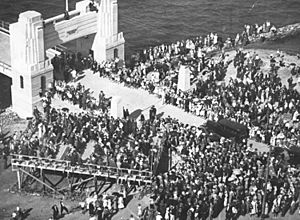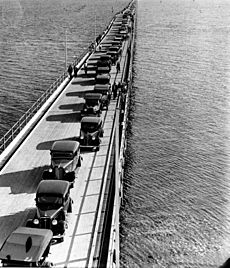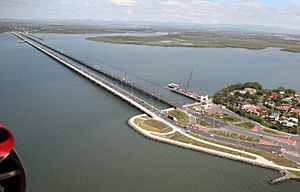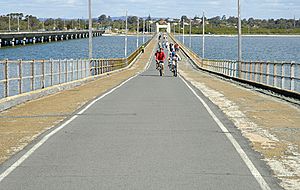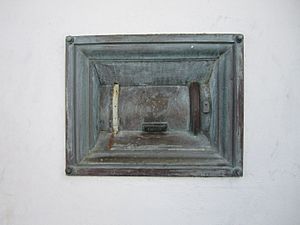Hornibrook Bridge facts for kids
Quick facts for kids Hornibrook Bridge |
|
|---|---|
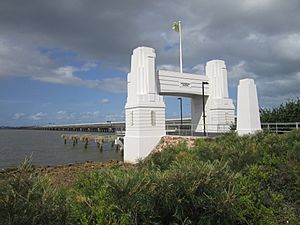
Hornibrook Highway Bridge Southern Portal, 2012 after the demolition
|
|
| Coordinates | 27°16′43″S 153°04′00″E / 27.278748°S 153.066802°E |
| Carries | trucks, bicycle |
| Crosses | Bramble Bay |
| Locale | Brisbane, Queensland |
| Heritage status | Queensland listed structure |
| Characteristics | |
| Design | Viaduct |
| Material | Wood |
| Total length | 2.684 km |
| Width | 7.92 m |
| Number of spans | 294 |
| History | |
| Designer | Sir Manuel Hornibrook |
| Construction begin | 8 June 1932 |
| Opened | 14 October 1935 |
| Closed | 14 July 2010 |
| Hornibrook Highway Bridge | |
|---|---|
| Lua error in Module:Location_map at line 420: attempt to index field 'wikibase' (a nil value). | |
| Location | Hornibrook Highway, Brighton, Moreton Bay Region, Queensland, Australia |
| Design period | 1919 - 1930s (interwar period) |
| Built | 1932–1935 |
| Architect | Manuel Hornibrook |
| Official name: Hornibrook Highway Bridge | |
| Type | state heritage (built) |
| Designated | 7 October 1994 |
| Reference no. | 601246 |
| Significant period | 1930s (fabric) 1935-1979 (historical use for road traffic) |
| Significant components | pier/s (bridge), kerbing and channelling, pylon/s, office/s, strong room |
| Builders | Manuel Hornibrook |
The Hornibrook Bridge was a famous road bridge in Queensland, Australia. It crossed Bramble Bay, connecting Brighton in City of Brisbane to Clontarf in the Moreton Bay Region. Sir Manuel Hornibrook designed and built the bridge between 1932 and 1935. It was listed on the Queensland Heritage Register in 1994.
The bridge had cool Art Deco concrete arches at its entrances. It was very important for the growth of the Redcliffe City area. It made the trip to Brisbane much shorter and faster. This helped more people move to Redcliffe and more visitors come to the seaside. Locals sometimes called the bridge the "Humpity Bump." This was because its road surface was uneven. During very high tides, waves would even splash onto cars crossing the bridge!
A private company owned and looked after the bridge. Drivers had to pay a small fee, called a toll, to cross it until 1975. The toll booths were located at the Clontarf (north) end of the bridge.
The Hornibrook Bridge was the first of three bridges built across Bramble Bay. The second bridge, the Houghton Highway bridge, opened in 1979. It was built to handle more traffic. The Hornibrook Bridge then closed to cars. It was used only by people walking or riding bikes. The third bridge, the Ted Smout Memorial Bridge, opened in 2010. After this, the old Hornibrook Bridge was mostly taken down.
Contents
Building the Hornibrook Bridge
The Hornibrook Highway Bridge was built from 1932 to 1935. It was constructed by M.R. Hornibrook's company. This project was a way to help people find jobs during the Great Depression. It also helped connect the Redcliffe Peninsula to the rest of Queensland. Before the bridge, getting to Redcliffe was hard. Roads often became muddy and unusable in wet weather.
Many plans were made to improve travel to Redcliffe. People wanted to make it easier for car owners and day-trippers to visit the seaside. M.R. Hornibrook saw a chance to develop the Redcliffe area. He decided to build a road bridge across the water from Redcliffe to Sandgate.
In 1931, Hornibrook asked the Queensland Government for permission to build a toll bridge. At first, they said no. But after more talks, a special law was passed. This law allowed private companies to build toll roads and bridges. Hornibrook got a forty-year agreement to operate the bridge.
The project was huge. It included a bridge about 2.68 kilometres (1.67 mi) long and new roads. To pay for it, Hornibrook created a company called Hornibrook Highway Ltd. He encouraged local people to invest in it.
Work started on June 8, 1932. But progress was slow at first because of money problems. The fancy entrance arches, called portals, were finished in early 1933. More money was needed to complete the bridge by 1935. A large loan from the AMP Society, guaranteed by the Queensland Government, helped. Work then sped up from July 1934.
The architect John Beebe designed the beautiful portals. He was a well-known architect in Queensland.
Bridge Materials and Records
Building the bridge needed a lot of timber. Over 2.5 million superfeet of wood was used for the main beams and the bridge deck. Two sawmills were bought just to cut timber from Mount Mee and Conondale Range. About 250 timber cutters were hired. The timber was floated down the North Pine and Pine rivers on barges. Hardwood for the piles and girders came from Hornibrook's own timber mill in Mapleton.
The concrete for the bridge came from the QCL works in Darra. The two portals were the first big structures in Queensland to use this local concrete.
The last wooden plank was put in place on September 7, 1935. The bitumen road surface was laid in less than three weeks, which was an Australian record! The bridge had two lanes for cars and a path for people to walk on.
When it was finished, the Hornibrook Bridge was the longest road bridge over water in the Southern Hemisphere. It was 2.684 kilometres (1.668 mi) long. It was also the second longest bridge in the world at that time, after the Maestri Bridge in the United States. Until it closed to cars in 1979, it was the longest road bridge in Australia.
The bridge opened to cars on October 4, 1935. This made the journey much shorter. A special bus service was also started to take people between Sandgate and Redcliffe.
The bridge was officially opened by the Queensland Premier, Arthur Edward Moore, on October 14, 1935. It was named after Sir Manuel Hornibrook, who was the main engineer for the project.
The Hornibrook Highway was important during World War Two. Military convoys used it to move war supplies quickly across Queensland.
Later Years and Demolition
In 1975, the Hornibrook Highway company gave control of the bridge to the Department of Main Roads. The department then became responsible for its upkeep. By this time, more and more cars were using the bridge. So, a new bridge was planned to handle the extra traffic.
The Houghton Highway bridge opened in 1979. It was built next to the Hornibrook Bridge. The original plan was to upgrade the Hornibrook Bridge too, but this was found to be too expensive. So, the Hornibrook Bridge closed to cars in 1979.
From 1979, the Hornibrook Bridge was only used by people walking and cycling. It was the only way for walkers and cyclists to get between Brisbane's northern suburbs and the Redcliffe Peninsula. It also became a popular spot for fishing and recreation. Even though the bridge was listed as a heritage site in 1994, there were worries about how much it cost to keep it safe.
A third bridge, the Ted Smout Memorial Bridge, opened in July 2010. This new bridge also had paths for walkers and cyclists. Since the Hornibrook Bridge was no longer needed for walking and cycling, it closed on July 14, 2010. Before it closed, the Hornibrook Bridge was the longest footbridge in the world. After its closure, the Poughkeepsie Bridge in the United States became the world's longest footbridge.
Even though the Hornibrook Bridge was a heritage site, its wooden deck was rotting. So, it was decided to take down most of the bridge in mid-2011. The north and south entrance arches (portals) were kept. Also, 100 metres (330 ft) of the bridge at the northern end was kept for fishing. This part was officially reopened on September 14, 2011, as the Hays Inlet Fishing and Recreation Platform.
The Hornibrook Highway played a big part in helping the Redcliffe Peninsula grow. Its planning, building, and operation were a great example of new construction ideas in Queensland during a tough economic time.
What the Bridge Looked Like
The Hornibrook Highway Bridge was about 2.685 kilometres (1.668 mi) long. It was made of timber and concrete. It had two identical concrete entrance structures, called portals, at each end. There were also two slightly higher sections along the bridge. These allowed small boats to pass underneath.
The bridge had a wooden top part supported by concrete pillars. These pillars had three concrete piles that went deep into the ground. The wooden top had strong ironbark beams. These beams supported the large ironbark and tallowwood timber deck. The deck was covered with a bitumen road surface and had concrete edges. The first sections of the bridge at each end were made of ribbed concrete. This was to protect the bridge from termites and fire.
The bridge had a slight curve that allowed its deck to be tightened over time. It also had steel railings and ironbark light poles along its length.
The portals at each end still exist today. They are grand Art Deco structures. They have tall pillars with a deep panel above them facing the land. They also have simpler rectangular frames facing the bay. The pillars have decorative bases and slot windows with metal grilles. The panel above has the words "Hornibrook Highway" in raised brass letters. These portals also contained the toll facilities. This included a small office and a strong room with a night safe inside the pillars.
Why it's a Heritage Site
The Hornibrook Highway Bridge was listed on the Queensland Heritage Register on October 7, 1994. This means it is an important part of Queensland's history and culture.
- Important to Queensland's History: It was one of the first toll roads in Queensland allowed by a special law. It was also a big public project built by a private company during the Great Depression. The bridge was key to Redcliffe's growth.
- Beautiful Design: The detailed and grand entrance portals at each end are considered very beautiful.
- Creative and Technical Achievement: The bridge's planning, building, and operation showed great new ideas in construction during a difficult economic time. It also shows the vision of its builder, Manuel Hornibrook, to help Redcliffe grow.
Q150 Icon
In 2009, as part of Queensland's 150th birthday celebrations (called Q150), the Hornibrook Bridge was named one of the Q150 Icons. It was recognized for being an amazing "structure and engineering feat."
Images for kids





